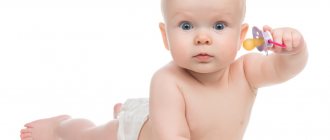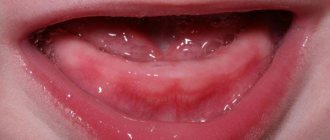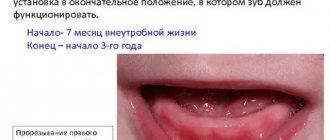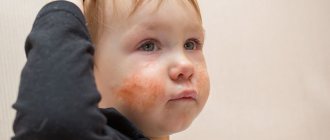How teeth are formed
The appearance of the first tooth is a milestone in a child's development. Now he's almost an adult! After all, his teeth will help him chew solid food and develop speech.
Baby teeth begin to form in the fetus as early as the 6th week of pregnancy. Between the 3rd and 6th months, enamel has already formed on the teeth. All this will be hidden under the gums for the time being. At the same time, deep in the jaw bone there are already the rudiments of molar teeth.
For most children, their first tooth appears between 4 and 7 months, but for some it happens later. With early development, it can erupt at 3 months or earlier. If the child grows normally and has no problems with skin and hair, then it’s okay. But if your baby is already 1.5 years old, and teeth have not appeared, you may need the help of a dentist.
The lower teeth usually appear about a month earlier than the upper teeth.
Approximate order of appearance of baby teeth:
- Lower central incisors (at 6 – 7 months).
- Upper central incisors (at 8 – 9 months).
- Upper lateral incisors (at 9–11 months).
- Lower lateral incisors (at 11 – 13 months).
- Upper small molars (molars) (at 12 – 15 months).
- Lower small molars (molars) (at 12 – 15 months).
- Upper canines (at 16 – 18 months).
- Lower canines (at 18 – 20 months).
- Lower large molars (molars) (at 24 – 30 months).
- Upper large (root) (at 23 – 30 months).
By age 3, your baby should have all 20 teeth, which will last until he is about 6 years old, when his first baby tooth falls out.
Don't be discouraged if your teeth grow crooked at first. Over time they will all fall into place.
The order of eruption of baby teeth
Everyone is different, but it is still important to know how most babies develop. Children's first teeth usually erupt almost simultaneously on the right and left. The sequence is as follows: first the anterior ones (incisors, canines), then the posterior ones.
It is important to understand that this pattern of teething in children is average, and in your case it may happen in a different order or at a different time. This does not necessarily indicate any violations.
Doctors have compiled an approximate, average diagram of teething in children:
Don't worry if you don't meet these standards for several months. If the parents got teeth late, most likely the children will have the same. Heredity has a very strong influence on development. The teething pattern should not become an unnecessary source of parental anxiety. This is just a guideline, like all other norms.
Both the sequence and timing of teething in children can vary greatly. Only if you are “late” by more than 6 months (for example, nothing appears until a year), it is worth discussing this with your doctor. There are genetic disorders when the rudiments of teeth do not develop at all. However, this is extremely rare. Some diseases also affect the timing of teething, but these conditions in children always manifest themselves with some more obvious symptoms.
In any case, there is no remedy that would “cut teeth” - we won’t pull them out of the jaw. We also do not regulate the cutting order. All that remains is to observe the process in children and take care of their health in general.
How to understand that your baby is teething (symptoms)
Many people believe that the process of teething must necessarily be accompanied by general anxiety of the baby, fever and diarrhea. However, not all experts share this point of view. Some consider this a mere coincidence. There is an opinion that children, when they start teething, are more likely to put dirty objects in their mouths to scratch their gums, and cause an infection.
Some lucky people go through this period painlessly.
But most children still experience some discomfort:
- Anxiety;
- Increased salivation, which can lead to facial irritation;
- The gums swell and become more sensitive;
- Refusal to eat;
- Bad dream.
If your baby has a fever or diarrhea, consult a doctor.
What problems may arise during teething in infants?
Difficulties do not always arise. But sometimes, about 3 days before and 3 days after teething, the baby’s condition changes:
- gums swell;
- saliva flows more strongly (although a lot of it can be released without connection with teething);
- the temperature rises slightly;
- mood deteriorates (child is less active, cries more often);
- sleep becomes restless;
- stools become slightly looser and more frequent;
- your cheeks turn slightly red (no need to immediately look for allergens and change your diet).
These symptoms may not all appear, in any combination.
The difficulty is that the same symptoms, but usually stronger, can also occur in children with infections. Therefore, if your condition has changed significantly, consult your doctor.
Red flags (tell your doctor if your child has):
- temperature above 38 degrees in the absence of cold symptoms;
- a rash that is unfamiliar to you, which appeared along with a high fever;
- diarrhea, vomiting;
- lethargy;
- mouth ulcers or other sores.
- Eruption cyst (hematoma).
Assess how much the child's condition has changed. If he begins to clearly feel unwell, there is no need to attribute this to the teething of baby teeth. In this case, you need a doctor to rule out more serious problems.
How to help your baby when teething
- Give your baby something to chew on, such as a teether, which can be pre-chilled in the refrigerator.
- Massage your baby's gums with a clean finger. You can first wrap your finger in clean gauze. This will relieve the pain for a while.
- If your baby is already eating solids, give him cool foods (applesauce or yogurt).
- You can give your child something hard to chew on, such as a cracker. Just make sure your baby doesn't choke.
- If all of the above does not help, you can give your child a baby pain reliever or a special teething gel - strictly after consulting a doctor.
Vomiting, runny nose and diarrhea are not always symptoms of teething. If your baby appears unwell, call the doctor.
Medicines for teething in children
When your baby is in pain, you would like to have a reliable, effective medicine that you can give and sleep peacefully. As in the case of colic, when teething, the pharmacy will offer you a variety of remedies. Pediatric experts do not advise giving any medications without a doctor's permission.
Why? Homeopathic medicines are divided into true homeopathic (containing no active substance at all, and therefore ineffective) or pseudo-homeopathic. The latter contain some amount of plant components (usually chamomile and other, more exotic plants). The first ones do not work under any conditions, including teething in children, but at least they are harmless. Homeopathic remedies for pain containing belladonna (which was not even always listed in the composition) caused many deaths and were therefore strictly prohibited in developed countries.
In our country, the Commission of the Russian Academy of Sciences recognized homeopathy as a pseudoscience, but, unfortunately, there is no strict ban on potentially dangerous drugs. Since manufacturers do not always indicate belladonna in the composition, we recommend that you generally refrain from using any homeopathic remedies for teething pain in children.
Another case is gels with a local anesthetic drug (their name ends in “-caine”: usually benzocaine or lidocaine). Medicines like these are “freezes” that are injected into the gums when treating teeth. Although these drugs are obviously effective, they have also caused many child deaths. Substances of this group affect the functioning of the heart, because the gel is quickly washed off with saliva, and the child swallows it. It is especially dangerous if the parent uses a higher dose than recommended in the instructions. This happens often because these drugs only relieve pain for a few minutes. When the baby starts crying again, the parents apply more, often exceeding the dose. Now professional communities of doctors do not recommend the use of products with local anesthetics, but this does not stop their widespread advertising.
Choosing a toothpaste and brush
Has your baby cut his first tooth? Congratulations!
- Until one year of age, parents need to brush their baby’s teeth without toothpaste using a special silicone brush placed on their finger at least once a day.
- At one year old, the baby needs to pick up his first children's toothbrush - without toothpaste for now. It is better if the child chooses it himself. She should interest him, but not scare him away.
What should you pay attention to when choosing a children's toothbrush?
- Decor - kids love bright colors and funny characters.
- The handle should be comfortable, preferably made of non-slip material with a protective ring to avoid injury. Its length should correspond to the age of the child.
- It is important that the brush head is not too large and awkward. The optimal size is 2–3 teeth of a child. To avoid damaging your gums, it is better to choose a brush with a rounded head.
- Soft brushes with a bristle height of no more than 11 mm are suitable for children. It should be even so that the pressure on the surface of the teeth is uniform.
- From 2 to 2.5 years old, it’s time to start using toothpaste and teach your child to brush his teeth on his own. You need to choose a special baby toothpaste without fluoride, because the baby may want to eat it. You can switch to fluoride toothpaste when he learns not to swallow it.
Deviations from the norm
After the mother has become familiar with the necessary sequence of growth of the child’s teeth, it is necessary to exclude the presence of deviations. There are cases where tooth growth is delayed or does not occur according to plan, and this is the norm. But sometimes doctors can say that deviations are pathological. How to determine what is normal and what is not?
Early appearance of teeth
If you think that your baby teethed very early, then you should think about the specificity of the hereditary predisposition or thyroid disease.
A rather rare but existing situation is when a baby is born with an existing incisor. In medical practice, such a manifestation occurs very rarely; it indicates a hormonal imbalance in the body. If there is a defect, it is more advisable to visit an endocrinologist to receive qualified treatment.
Late appearance of teeth
Young mothers sound the alarm when the child’s first tooth makes itself felt only at the end of the first year. However, medical specialists do not always consider this course pathological. If children are missing at least one tooth per year, it is more advisable to visit a dentist and pediatrician.
An interval between tooth formation lasting more than 60 days is considered abnormal. In this case, the defect is due to a reduced calcium content, poor absorption of vitamin D and other pathologies.
How to brush your teeth correctly
- Your baby's teeth need to be brushed 2 times a day - in the morning and in the evening before bed.
- Use a small amount of toothpaste at first, about the size of a grain of rice, then work up to a pea-sized amount.
- If you use such a small amount of toothpaste, there is no need to rinse your mouth.
- Brush your teeth gently from the outside and inside.
- The tongue also needs to be cleaned, because bacteria accumulate on it, causing bad breath.
- Remember to change your toothbrush every 3 months.
At this stage, it is too early to floss because the teeth are usually far apart.
Caring for emerging teeth
Teething is an absolute reason for making the first visit to the pediatric dentist. During the consultation, the doctor identifies all deviations in the structure of the child’s dental apparatus, assesses the condition of the frenulum of his lips and tongue, draws up a dental care plan and a plan for preventive visits to the dental clinic.
It is advisable to brush emerging teeth twice a day. Initially, you should use a baby silicone brush or a small piece of gauze without toothpaste for cleaning. A regular toothbrush can be used when the child is one year old, and toothpaste when he reaches two years of age. In addition, it is important to pay attention to the process of enamel mineralization. In particular, it is necessary to limit the consumption of sweets and include foods enriched with calcium, phosphorus and ascorbic acid in the baby’s diet.
Creating a good habit
The habit of brushing your teeth should be established in childhood. If you don’t force your child, but figure out how to turn this activity into an interesting game, your baby will brush his teeth with pleasure. Here are some tips:
- Children love to copy adults, so lead by example by brushing your teeth with your child.
- If you brush your teeth with your baby, at the end open your mouth and show each other how you handled this “task.” If necessary, clean your child's teeth yourself.
- Don't scold him, no matter how badly he cleaned it. Children at this age have not yet developed fine motor skills, so do not expect precise movements from them.
- Let your child associate brushing his teeth with something joyful. Play his favorite children's music, tell him stories about teeth, and draw on a dental theme.
- Keep a piece of paper with a schedule for brushing your teeth. Divide the day into morning and evening (you can draw the sun and moon there) and check the box when you brush your teeth.
- Finally, talk to your child like an adult. Explain to him why brushing his teeth is good. Draw scary microbes on a piece of paper and together figure out how you can fight them.
If your little one refuses to brush his teeth, try buying him a new toothbrush with his favorite cartoon character on it. Get him interested. Get several toothbrushes and let him choose a new one each time.
Formation of milk bite
The process of building a human bite has 5 stages, and all of them occur in childhood.
Each of the five stages is important for the final formation of the entire dental system and dental occlusion:
The first stage is from birth to 6 months (before the appearance of the first teeth).
The second stage is the period of eruption of all baby teeth in a child (6 months - 3 years).
The third stage is the period of jaw growth, preparation for the natural change of milk teeth to permanent ones (3-6 years).
The fourth stage is the time of active growth of the jaws and the eruption of permanent teeth (6-12 years).
The fifth stage is 12-15 years old, when the child’s baby teeth have already changed and all teeth are permanent.
Correct formation of the primary dentition is one of the main conditions for the development of a correct permanent dentition in a child.
What microelements are needed for teeth growth?
Fluorine
Fluoride strengthens tooth enamel, making it more resistant to acids and harmful bacteria. Thus, it helps prevent the development of caries.
Fluorine is found in:
- Toothpaste - however, remember that toothpaste with a small fluoride content can only be used by children over 4 years old;
- Fluoride-enriched water;
- Chewable tablets or drops;
- Some fruit juices.
Remember that too much fluoride can lead to fluorosis, which is when white spots appear on the teeth. Therefore, it is important not to use too much toothpaste, especially if the child has not yet learned to spit it out.
Calcium
Calcium takes an active part in the mineralization of teeth. A 3-year-old child should receive 800–1100 mg of calcium per day.
Products containing calcium:
- Milk, yogurt;
- Spinach and other green leafy vegetables;
- Broccoli;
- Fish.
In order for calcium to be better absorbed, it needs helpers. One is vitamin D and the other is vitamin K2.
Vitamin K
Calcium is collected and transported into bone tissue using the protein osteocalcin, which normally “dormants” peacefully in the blood. In order to activate it, you need natural vitamin K. It is found in dairy products (milk, yogurt, kefir, cottage cheese - for example, Agusha K2 cottage cheese).
Treatment.
Providing QUALITY dental care to children from the moment the first tooth appears and up to 3 years of age is LIMITED to physiological reasons: mild excitability, restlessness, fear of unknown manipulations in the oral cavity. An attempt to cure teeth by talking to a child or holding him by force in his arms ends with POOR-QUALITY treatment, as a result of which various local complications can develop.
REMEMBER: FORCED TREATMENT WITH CHILDREN RESTRAINT CAUSES IRREPAIRABLE PSYCHOLOGICAL TRAUMA TO THE CHILD!
Like
When should I take my child to the dentist?
The Ministry of Health of the Russian Federation recommends showing a child to the dentist once a year starting from 12 months.
The purpose of the first trip to the dentist is prevention. The doctor checks whether teeth are growing correctly and gives recommendations on oral hygiene. It is better to do this no later than your first birthday, so that the specialist does not miss caries and possible problems with your bite.
The first trip to the dentist should not frighten your child.
Here are some tips to make it painless:
- Do not pay too much attention to this event, do not prepare your child on purpose;
- Don’t worry yourself so that your baby doesn’t get nervous along with you;
- If possible, arrive early to your appointment to give your baby time to look around.
Should I worry?
It is important for parents to understand that the cutting of the first molars is often quite difficult; you should not be afraid of many manifestations. Let's figure out when there is no need to panic, what is the norm. The following symptoms are not considered a cause for concern:
- Copious secretion of saliva. In general, this is typical for most children between 10 weeks and 4 months. Just stock up on bibs and you won't have to worry about hygiene;
- Skin irritation (area around the mouth, chin). This symptom is the result of the same salivation, so do not forget to dry your baby’s skin in time and use an emollient cream before bed;
- Frequent desire to take the breast. This is explained by the desire to scratch the gums; this is normal and should not be denied to the child; it usually goes away pretty soon.
When there is cause for concern
In order for the new molar to erupt as easily as possible, it is necessary to pay a lot of attention to the child; also, each little person has his own pain threshold. Usually the most difficult thing in this regard is the appearance of the very first teeth, as well as the incisors.
Sometimes while breastfeeding, the baby's pain increases so much that he begins to refuse to eat. If you miss 2-3 feedings, you should not worry, but if this number is exceeded, you need to consult a pediatrician.
Also, loose stools are not considered normal; it is caused by excessive salivation during teething. As described above, persistent diarrhea with the appearance of blood should not be underestimated.
What else to pay attention to
It happens that small bumps appear on the gums, that is, a minor hematoma. But you shouldn’t be afraid of this, the formation resolves on its own, cold compresses help a lot.
Sometimes, when the incisors are getting ready to appear, pain also occurs in the chin and ears. The child begins to rub his face or chin, but sometimes this is also a symptom of an inflammatory process in the ear, so a consultation with a specialist will not be superfluous.
A little advice: if the baby is spinning in bed and does not fall asleep, you should not immediately calm the child down, it is better to let him deal with it on his own. You need to pick it up and give it milk when you can’t fall asleep for a long period of time.
Another difficulty is increased salivation, due to which the child begins to cough, and when mucus gets into the nasopharynx, an accompanying runny nose develops. If there are additional symptoms that cause concern, you should contact your pediatrician.










